
This article about complex numbers is a little advanced. See here for a basic introduction to complex numbers.
Every positive real number has two square roots, one being the negative of the other. It's easy to tell them apart by specifying whether you're looking at the positive or the negative square root. This means you can unambiguously define the square root function
$$f(x)=\sqrt{x}$$ over all the non-negative real numbers (the positive real numbers and 0).
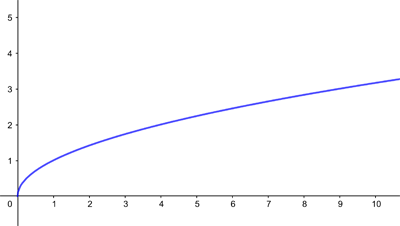
The graph of the positive square root function defined over the non-negative real numbers.
When it comes to the square root of complex numbers, things are a little tricker. Before we start, let's have a quick look at Euler's formula, which gives us a way of writing complex numbers that is convenient when it comes to taking square roots (see this article for more detail on Euler's formula).
Euler's formula
First remember that a complex number $z$ can be written as $x+iy$ where $i^2=-1$ and $x$ and $y$ are real numbers. You can associate a complex number with the point in the plane that has Cartesian coordinates $(x,y)$.
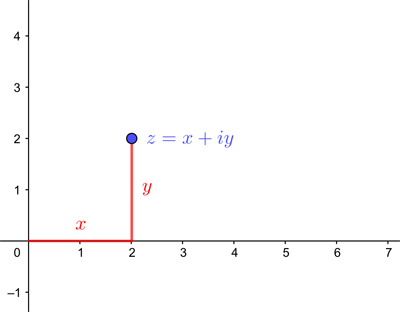
A complex number represented as a point on the plane in Cartesian coordinates.
Euler's formula tells us that $z$ can also be written as
$$z=re^{i\theta},$$ where $(r,\theta)$ are the \emph{polar coordinates} of the point in the plane associated to $z$. Here $r$ is the distance from that point to the point $(0,0),$ and $\theta$ is the angle formed by the line connecting the point to $(0,0)$ and the positive $x$-axis (measured anti-clockwise).
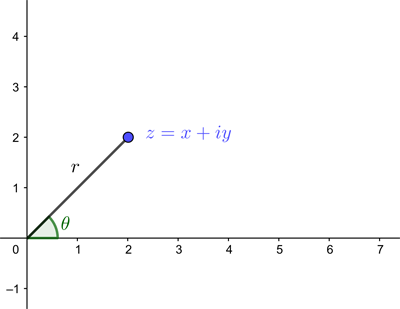
A complex number represented as a point on the plane in polar coordinates.
See see this article to find out why this is true.
This is the representation of complex numbers we will use in this article. The reason is that taking a square root of a number involves raising that number to the power $1/2.$ Using the exponential representation of complex numbers makes this easier. Before we carry on, we note two things. The first is that, for any positive real number $r$ and angle $\theta$, we have $$re^{i\theta}=re^{i(\theta+2\pi)}.$$
You can convince yourself that this is true by noting that the point with polar coordinates $(r,\theta)$ is the same as the point with polar coordinates $(r,\theta+2\pi)$. That's because the angle $2\pi$ corresponds to a full turn of the circle, so adding $2\pi$ to a polar angle gets you back to where you started.
The second thing to note is that we can also say what we mean by $$re^{-i\theta},$$ where $\theta$ is positive. Since $$re^{-i\theta} = re^{i(2\pi-\theta)}$$ we can think of the complex number $re^{-i\theta}$ as represented by the point at distance $r$ from $(0,0)$, with the angle $\theta$ measured in the clockwise, rather than anti-clockwise, direction from the positive $x$-axis.
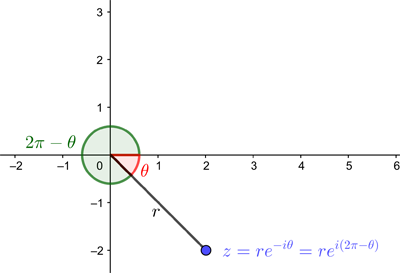
A negative angle can be interpreted as an angle measured in the clockwise direction from the positive x-axis.
Taking the square root
When it comes to the square root of a complex number $z=re^{i\theta}$ we again have two options, as we did for square roots of real numbers. The first is $$ \sqrt{r}e^{i\frac{\theta}{2}}.$$ Let's just check this works: $$\left(\sqrt{r}e^{i\frac{\theta}{2}}\right)^2=\sqrt{r}^2\left(e^{i\frac{\theta}{2}}\right)^2=re^{i\theta},$$ as required. The second option is $$\sqrt{r}e^{i(\frac{\theta}{2}+\pi)}.$$ Again let's check: $$\left(\sqrt{r}e^{i(\frac{\theta}{2}+\pi)}\right)^2=\sqrt{r}^2\left(e^{i(\frac{\theta}{2}+\pi)}\right)^2=re^{i(\theta+2\pi)}=re^{i\theta},$$ as required.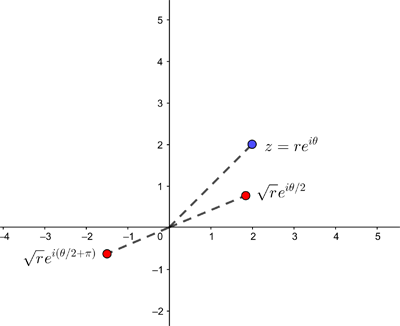
The two square roots (shown in red) for z (shown in blue).
Our two expressions, $$ \sqrt{r}e^{i\frac{\theta}{2}} \;\;\; \mbox{and}\;\;\; \sqrt{r}e^{i(\frac{\theta}{2}+\pi)}$$ are called the two \emph{branches} of the square root.
Defining a function
Let's start by defining our square root function $f(z)$ on the non-negative real line. We will define the function so that for a real number $x$ on this non-negative real line, the function corresponds to the positive square root $\sqrt{x}$. This means that we need to choose the first of our two branches above, so $$f(re^{i\theta})=\sqrt{r}e^{i\frac{\theta}{2}} \;\;\;\mbox{if } \;\;\; \theta =0.$$ Let's see what happens if we extend this definition to a little sector of the complex plane which contains the non-negative real line. For example, let's define $$f(re^{i\theta})=\sqrt{r}e^{i\frac{\theta}{2}} \;\;\;\mbox{if} -0.4 \leq \theta \leq 0.4.$$ The Geogebra applet below illustrates that there is no problem with this definition. It is un-ambiguous and also gives us a continuous function: when you use the sliders to vary $r$ and $\theta$, you see that $f(z)$ (shown in red) changes continuously as $z$ (shown in blue) changes.Why can't we define our function on the whole plane in the same way? Well, consider what happens as you approach a point on the negative real line from above and from below. We can approach the point from above by looking at points $z=re^{i\theta}$ with $\theta$ increasing from $0$ to $\pi$. Since our function is $$f(z)= \sqrt{r}e^{i\frac{\theta}{2}},$$ the value of $f(z)$ approaches $$\sqrt{r}e^{i\frac{\pi}{2}}=\sqrt{r}i.$$ To approach our point from below we can look at points $z=re^{i\theta}$ with $\theta$ decreasing from $0$ to $-\pi$. Since our function is $$f(z)= \sqrt{r}e^{i\frac{\theta}{2}},$$ the value of $f(z)$ now approaches $$\sqrt{r}e^{-i\frac{\pi}{2}}=-\sqrt{r}i.$$ Therefore, if we defined our function as $$f(z)= \sqrt{r}e^{i\frac{\theta}{2}}$$ on the whole complex plane, it would not be continuous on the negative real line. As we approach a point $z$ on the negative real line from above, the function $f(z)$ approaches $\sqrt{r}i$, but as we approach $z$ from below, the function approaches $-\sqrt{r}i$. You can see this in the Geogebra applet below. Use the slider for $\theta$ to move it towards $\pi$ (to the right) and towards $-\pi$ (to the left).
The problem of the discontinuity doesn't occur just because we chose the "wrong" branch to define our function. If we had chosen to define the function as $$f(z)= \sqrt{r}e^{i(\frac{\theta}{2}+\pi)}$$ in an analogous way, it would also have been discontinuous on the negative real line. In summary, the complex square root is a \emph{multi-valued} function that can't be defined un-ambiguously on the whole complex plane in a way that makes it continuous.A new surface
There is, however, a clever trick that gets us around this problem. The idea is to create a new surface on which it is possible to define a function for the complex square root in a continuous way. We start by taking two copies of the complex plane and cutting each along the negative real axis (such a cut is called a \emph{branch cut}). On one copy of this cut complex plane we define $$f(z)= \sqrt{r}e^{i\frac{\theta}{2}},$$ and on the other we define $$f(z)= \sqrt{r}e^{i(\frac{\theta}{2}+\pi)}.$$Now we glue the top edge of the cut of the first copy to the bottom edge of the cut of the second copy, and vice versa (this is hard to imagine but hang in there). On the resulting surface (called a Riemann surface) the square root function is now defined unambiguously and continuously.
To illustrate this, look at points $z=re^{i\theta}$ on the first copy, with $0\theta>-\pi$, and decrease $\theta$ towards $-\pi.$ This means you are approaching the bottom edge of the cut on the second copy of the plane. Since on that second copy the function is defines as $$f(z)= \sqrt{r}e^{i(\frac{\theta}{2}+\pi)},$$ the value of $f(z)$ approaches $$f(z)= \sqrt{r}e^{i(-\frac{\pi}{2}+\pi)}=\sqrt{r}e^{i\frac{\pi}{2}}=\sqrt{r}i$$ as $\theta$ approaches $-\pi$. And since the top edge of the cut in the first copy of the plane has been glued to the bottom edge of the cut in the second copy of the plane, the function is now continuous on the line that comes from gluing together the two edges.
This is an illustration of the Riemann surface that comes from the cutting and gluing:
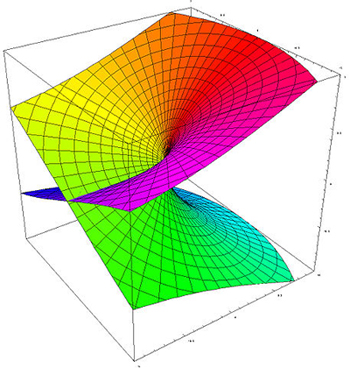
The Riemann surface associated to the complex square root, represented in three dimensions. A loop around the point 0 on this surface (which is right at the centre) will take you once around the top sheet and once around the bottom sheet. Figure: Jan Homann.
When you try to create this surface in three dimensions you run into problems: once you have glued the top edge of the cut of one copy of the plane to the bottom edge of the cut of the other copy of the plane, the two remaining free edges of the cut end up on different sides of the surface you have created so far. So the only way to glue those free edges together is to allow the surface to pass through itself. This is why a three-dimensional representation of this Riemann surface, like the one above, intersects itself. To get a surface that doesn't self-intersect you need to move into the fourth dimension.
The complex square-root isn't the only multi-valued function. Another example is the complex logarithm, which actually has infinitely many values. In this case the associated Riemann surface is a beautiful infinite stair case (of which a finite section is shown below).
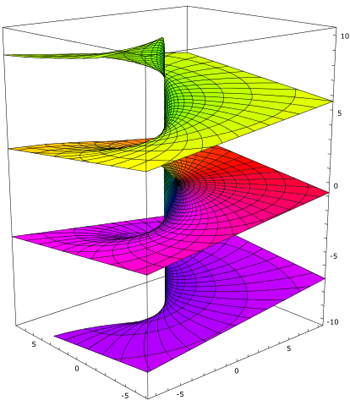
The Riemann surface associated to the complex logarithm. Figure: Leonid 2, CC BY-SA 3.0.
About this article
Marianne Freiberger is Editor of Plus.
This article is part of our collaboration with the Isaac Newton Institute for Mathematical Sciences (INI), an international research centre and our neighbour here on the University of Cambridge's maths campus. INI attracts leading mathematical scientists from all over the world, and is open to all. Visit www.newton.ac.uk to find out more.
